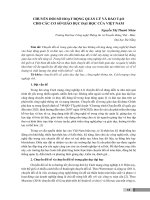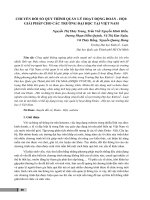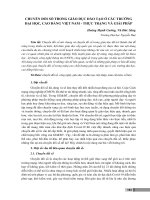(TIỂU LUẬN) chủ đề thế hệ trẻ với chuyển đổi số
Bạn đang xem bản rút gọn của tài liệu. Xem và tải ngay bản đầy đủ của tài liệu tại đây (409.72 KB, 20 trang )
BỘ GIÁO DỤC VÀ ĐÀO TẠO
TRƯỜNG ĐẠI HỌC KINH TẾ TP. HỒ CHÍ MINH
ĐỀ TÀI NGHIÊN CỨU KHOA HỌC THAM GIA HỘI THẢO KHOA HỌC LẦN I 2021
Hồ Chí Minh, ngày 30 tháng 4 năm 2021
Nguyễn Hoàng Long
KE001-Đại học Kinh tế TP.HCM
0396034236
Lĩnh vực nghiên cứu chuyên sâu: Công nghệ thông tin.
A STUDY OF FACTORS AFFECTING THE BEHAVTORAL INTENTION OF USING
CRYPTOCURRENCY – BITCOIN IN VIETNAM: A CASE STUDY IN HO CHI MINH
CITY
Chủ đề: Thế hệ trẻ với chuyển đổi số.
Số từ :5358
Mô tả: Hưởng ứng phong trào nghiên cứu khoa học tại UEH, tác giả đã lên kế hoạch cũng như
có các ý tưởng để tham gia. Với sức nóng của tiền điện tử Bitcoin đang được nhắc đến mỗi ngày
trong cuộc sống, đó là một điều khơng q khó khăn để tác giả có thể nhận ra giá trị của đồng
tiền này tác động thế nào đến cuộc sống của thế hệ trẻ hiện nay. Qua tìm hiểu, tác giả nhận thấy
chủ đề về Tiền điện tử còn chưa phổ biến ở Việt Nam. Và đó chính là lý do và mục tiêu đóng góp
của bài nghiên cứu này.
1
A STUDY OF FACTORS AFFECTING THE BEHAVTORAL INTENTION OF USING
CRYPTOCURRENCY – BITCOIN IN VIETNAM: A CASE STUDY IN HO CHI MINH
CITY
Abstract: With the rapid development of technology in industrial revolution 4.0, Vietnamese
people become more and more catch closer to the globalization. And Bitcoin- crypto-currency is
one of these adapting process. This research is about to understand the factors that affect the
acceptance and using of Bitcoin crypto-currency in Vietnam. It adopted the model of Unified
Theory of Acceptance and Use of Technology (UTAUT), the author identified four influencing
factors: Performance Expectancy, Effort Expectancy, Social Influence and Facilitating
Conditions. The factor of Gender and Age were assumed to moderate the relations between those
factors and use and behavioral intention. Based on data collected from 102 students and
employees in Ho Chi Minh City and the statistical significance of the relationships evaluated by
multivariate regression analysis, the results show that Social Influence and Perceived Usefulness
are the main factors affecting the user in using Bitcoin technology.
Keywords: Bitcoin, Unified Theory of Acceptance and Use of Technology, crypto-currency,
Behavioral Intention.
1. INTRODUCTION
The development of Internet today has brought out so many new technologies in the
world including electronic money or crypto-currency- Bitcoin. Bitcoin is the most typical,
first born and widely used in e-commerce. It is a decentralized financial protocol based on
the peer- to- peer network. It is a capable of connecting any computer throughout the
world for establishing an open accounting book (Feld, Schõnfeld & Werner, 2014). In
other words, Bitcoin is a new payment transaction system where the money is in digital
form. By using Bitcoin, anyone is able to send money to anywhere instantly. Bitcoin was
established by anonymous who referred to himself as Satoshi Nakamoto in November
2008.
Recently, Statista’s Global Consumer Survey announced that Vietnam ranked second
worldwide in popularity of crypto-currency. This shows that Bitcoin is becoming familiar,
2
but the question arises, can it replace real money or not? It is transforming and being
recognized as a new currency.
I.1 Reason of choosing the topic:
Banknote is a vastly innovation. ‘Currency’ is an intermediate product used to trade
goods. And the logic of money is based on consensus. That means, the Central Bank is
allowed to issue currency because they get a consensus of the majority in terms of
interests to protect value.
However, nobody guarantees the pure safety of the Central Bank and ensure that they do
not add money into economy and lead to inflation. What we need is to find a solution for
both the government and the community to use money better and limit the potential
damage to the economy. And Bitcoin is the answer for this problem. In fact, Bitcoin gains
over the traditional currency for its benefits.
In Vietnam, with the popularity of crypto-currency ranked second in the world, cryptocurrency is one of the most important factors that contribute the globalization, however,
there is no official research of this area to survey and assess the needs, attitudes and
acceptance of Bitcoin . Therefore, I choose the topic ‘Factors affecting the behavioral
intention of using crypto-currency –Bitcoin in Vietnam’. Based on this study, the State
Bank, related agencies, and organizations will have right strategies to promote the
development of Bitcoin in Vietnam or the developers, end consumers to know more about
Bicoin.
I.2 The research objectives:
Discover the factors that affect the behavioral intention of using Bitcoin in Vietnam.
Measure the factors and the impact of each factor on the behavioral intention of using
Bitcoin in Vietnam.
Recommend some solutions to increase the behavioral intention of using of Bitcoin in
Vietnam.
2. LITERATURE REVIEW:
2.1Theoretical basis:
2.1.1Characteristics of money and electronic money:
3
Currency means payment in exchange for goods or services. Gold or silver coins and
banknotes circulating in society represent means or values. Banknotes currently in use
have intrinsic value, people give the banknote to the other party when they believe that
they get exactly what value they want. It has the value of money in the door. In other
words, the concept of money can be seen as trust and promise in payment.
Electronic money refers to the concept of such money as an IC card or net. Cash by
electronically storing it on the computer connected to the work. It is an alternative
currency. E-money is easy to store and transfer value and where it has versatility that can
be used or used, and when it has key functions as a currency such as guaranteeing
anonymity. Therefore, it is used to replace a large portion of cash transactions.
Money is a concept of credit, whereas is a conventional currency. In that view, the
meaning of money and electronic money are quite different. Looking at the defined
research, money has a wide variety of meanings, which are included, and are largely a
means of payment and debt for goods and services. It can be defined as a means of
implementation, a means of value storage, etc. (MNLee, 2006.)( GOJeong, 2008.)
2.1.2 Features and acceptance factors of crypto- currency:
Virtual currency is a type of electronic money, and it is network-based. Cryptocurrency is
the government of each country or unlike the general currency issued by the central bank.
It is valued according to the rules set by people, and exchanged with real money. It is
distributed on the premise that it can be exchanged. (Naver Encyclopedia, 2014)
Cryptocurrency is currency which has no production cost due to issuance of waste, and
transfer costs, etc. It has the advantage of significantly reducing transaction costs.
Moreover, because it is stored on disk, there is no storage cost, and as there is no fear of
loss or loss, the function is also excellent. However, due to the confidentiality of the
transaction, It can be abused in legislation, and due to difficulty in taxation, it can be a tax
measure, which is a problem (Naver Encyclopedia, 2014). Hyundai Research Institute
(Hyundai Research Institute, 2014.) exchanges virtual currency with real money
classified into point type, cyber money type, and alternative currency type according to
gender. Point type is not exchanged for real money, but it is used to purchase goods and
services in a designated place. Credit card points, gas station mileage, etc. …It belongs to
this. The cyber money type converts virtual currency into real money. ‘You can buy it, but
4
you cannot convert virtual currency into real money’ is the case which is used in online
games, etc… 'Bitcoin' is a type that can be exchanged freely .It can be said to be a target
example. Crypto-currency will be used in the future IT technology development and trend
change. Therefore, there are methods such as fusion between types and integration
between different crypto-currencies, which will continue to evolve, and due to the
evolution of the virtual currency ecosystem, create a new industry, reducing transaction
costs, expanding investment, etc. This also contributes to activation. Besides, cryptocurrency exchange and tax the safety and transparency of transactions due to the
reorganization of laws and systems, and concerns about current side effects will gradually
decrease.
2.1.3 Theory of reasoned action (TRA)
Theory of Reasoned Action was first developed in 1967 by Fishbein, then modified and
expanded by Ajzen and Fishbein (1975). According to this theory, the behavioral intention
is the best predictor of a person's behavior on the basis of judgment to make choices in the
decision-making process. As said by Ajzen and Fishbein (1975), behavioral intention is
influenced by attitude towards behavior and subjective norm of behavior. In particular, the
attitude towards using behavior is measured through customer’s trust in the product (in
this case, a technology product). Customers pay attention to the attributes that bring
essential benefits and have different levels of importance. If we know the weights of those
attributes, we can roughly predict the customer choices. Social influence factors can be
measured through people related to the consumer (like family , friends, colleagues,...);
These people like or dislike when they buy. The level of Social Influence affecting a
customer's buying tendencies depends on the level of support or opposition to consumer’s
buying behavior and their motives following the wishes of influencers. In summary,
according to the Theory of Reasoned Action, the customer's behavioral intention is
influenced by their trust in the benefits that the product provides and the influence of
those around them on that behavior. However, a shortage of TRA is that it ignores social
factors that may also motivate consumers.
2.1.4 Theory of planned behavior (TPB)
Theory of Planned Behavior (Theory of Planned Behavior - TPB) is an extension of the
TRA theory to overcome the shortage of the TPB that the consumer behavior is the
5
rational thought. This theory was added by Ajzen in 1991 with a third factor, the
Perceived Behavioral Control. This third one reflects how easy or difficult it is to perform
the behavior. As more opportunities and resources are available, the consumer thinks that
there is less impediment and greater cognitive control of the behavior. This control factor
can be internal factors (will, ability, ...) or external factors (time, performance
opportunities, economic conditions, ...). However, the TPB model has some limitations in
predicting behavior (Werner, 2004), because there may be a number of other factors that
influence behavior. Research shows that only 40% of behavioral variation can be
explained by using TPB (Ajzen, 1991; Werner, 2004). The second limitation is that there
can be a significant time gap between assessments of behavioral intention and actual
behavior evaluated (Werner 2004). Over a period of time, an individual's intentions may
change. The third limitation is that the TPB is a model that predicts an individual's
behavior based on certain criteria. However, the individual does not always behave as
predicted by these criteria (Werner 2004).
2.1.5 Technology acceptance model: TAM
In applying the technology field of individuals, the TAM model is one of the most
extensive research. In 1989, Davis proposed the Technology Acceptance Model (TAM) to
explain the potential consumer's behavioral intentions to use technological innovation.
TAM is developed based on the Theory of Reasoned Action (TRA), a psychological
theory that tends to explain customer behavior.
The original TAM model and extended version one both have been used to explain and
predict the intention to adopt and use technology in Bitcoin (: Daniel Folkinshteyn &
Mark Lennon (2016) Braving Bitcoin: A technology acceptance model (TAM) analysis,
Journal of Information Technology Case and Application Research), M-learning (S. R. G
et al., 2007), online banking (L. V. S et al., 2007), online shopping payments (L. Zhou et
al., 2007), electronic and multimedia environments, mobile payment services (PG Schierz
et al., 2010) and . TAM (Davis, 1989; Davis et al., 1989) has proposed that two specific
beliefs, the Perceived Usefulness and the Perceived Ease of use are the main motivations
of technology adoption. The Perceived Usefulness stands for “the level to which a person
believes that using a particular system would enhance his or her job performance ”and
6
Perceived Ease of use stands for“ the level to which a person believes that using a
particular system would be free of effort. ”(Davis, 1989).
According to Pavlou (2003), the benefits of TAM include reliable tools with good
metrological attributes, brief and experimental. Furthermore,when compared with the
alternative acceptance models, TAM has a competitive advantage in explaining a
significant proportion of the variable in the using intention (Venkatesh 1999). Therefore,
we believe that the TAM technology adoption model is one of the hypotheses proposed in
this research with additional theoretical basic structures important for the acceptance of
Bitcoin.
2.2 Conceptual model and hypothesis development:
The author proposes the factors affecting the behavioral intention of using Bitcoin of
citizen of Ho Chi Minh city include 05 elements : Perceived Ease of Use; Social
Influence; Perceived Security and Perceived Usefulness. The author through reference to
previous studies and the result of interviews adjust the proposed model. Specifically, the
author made adjustments and additions to the factors affecting the behavioral intention of
using Bitcoin of HCM citizen to fit the research objectives of the topic.
Figure 1. Conceptual Model
7
Perceived Ease of Use (PEU):
The perceived ease of use is defined as the degree to which an individual has confidence
to use/operate a particular technology/system by utilizing less effort (Davis, 1989).
Individual beliefs about the perceived ease of use are based on several factors related to
the use of computer. For instance, such factors include computer playfulness, selfefficacy, and the role of the computers to reduce anxiety level and external control
(Shahzad et al., 2018). It is found that familiarity and sufficient experience to use
computer may boost self-efficacy of the individual and lessen the anxiety associated with
the early adoption of modern technologies (Abu-Shanab & Haider, 2015; Almuraqab,
2017; Venkatesh & Bala, 2008). Some studies have validated the positive relationship
between the perceived ease of use and the behavioral intention in different research
contexts (L. Chen & Aklikokou, 2020; Wang et al., 2020). Scholars argued that there is a
need to lower the technological entry barrier to engage with the cryptocurrencies
(Fröhlich et al., 2020). According to Miau and Yang (2018), Bitcoin networks include a
variety of computing devices (i.e., laptops, smart phones, mainframes) that can be easily
accessible and used. This leads to the first hypothesis:
Hypothesis H1: Perceived Ease of Use has a positive effect on the Behavioral Intention of
Using Bitcoin.
Perceived Usefulness (PU):
The perceived usefulness is defined as the degree to which an individual assumes that the
use of particular technology or system would be helpful and beneficial for him or her and
may boost overall performance of any given activity (Davis, 1989; Davis et al., 1989).
The extant literature shows that the perceived usefulness has a continuous effect on the
behavioral intention to use technology in future (Almuraqab, 2017; L. Chen & Aklikokou,
2020; Venkatesh et al., 2003; Wang et al., 2020). Practitioners argue that the perceived
usefulness is an essential factor determining the adoption of novel technologies (Tan &
Teo, 2000). The use of cryptocurrencies can be influenced by the perceived usefulness
affecting the adoption of cryptocurrencies (Shahzad et al., 2018). Thus, the following
hypothesis is proposed:
8
Hypothesis H2: Perceived Usefulness has a positive effect on the Behavioral Intention of
Using Bitcoin.
Social Influence (SI):
Social Influence is defined as the degree to which an individual's views and interests on a
new technology that is trusted and suggested by others to use the new technology.
According to another study on crypto-currency adoption based on the TPB, subjective
norms (social influence) is significant (Schaupp and Festa, 2018): people receiving a
positive social influence regarding their use are more likely to use them.
Hypothesis H3: Social Influence has a positive effect on the Behavioral Intention of
Using Bitcoin.
Perceived Security (PS):
Security is defined as the events, conditions, or circumstances with the possibility to cause
economic hardship to network resources or data in the form of restriction, modification,
disclosure of data, violation of privacy, fraud, abuse, and waste and denial of services
(Balta-Ozkan et al., 2013; Han & Yang, 2018; Yang et al., 2016). Several scholars defined
security as the protection of data/systems from intimidation interference and unlawful
alteration/loss or embezzlement (Bailey & Pearson, 1983; Santhanamery & Ramayah,
2018). The online payment systems require rigorous and fool-proof security arrangements
to protect their users from any sort of loss. Individuals participating in online transactions
have deep concerns about the overall security arrangements of the systems that they use
for receiving or paying money. The high/low level of security of an online system leaves a
positive/negative impact on the users, which leads to acceptance/rejection of the said
system. Therefore, every online payment system shows strong commitment to its security
arrangements to avoid any uncertain events.
Regarding Bitcoin, scholars defined security and control as the overall security
arrangements of the Bitcoin system (Abramova & Böhme, 2016). Bitcoin system is
considered secure compared with other existing payment mechanisms (Kasahara &
Kawahara, 2017), and it provides a secure and immediate services of international fund
9
transfer (Kawase & Kasahara, 2020). It is reported that one essential aspect of Bitcoin is
the mining process, which describes the overall security, stability, and reliance on the
payment system (Nakamoto, 2008). It is also revealed that Bitcoin has performed well
without major setbacks since its launch (Bentov, 2017).
Hypothesis H4: Perceived Security has a positive effect on the Behavioral Intention of
Using Bitcoin.
2.3 Methods
2.3.1 Measurement scale:
I used a questionnaire constructed by using a 5-point Likert scale to measure variables.
The items in the questionnaire were based on previous studies regarding the acceptance of
financial technologies. The scale measurements are detailed in Table 1.
Table 1. Measurement details
Construct
Perceived Ease
Item
PEU1: It is understandable and easy for
Source
Venkatesh and Davis
of Use
me to use Bitcoin.
(2000)
Shahzad et al (2018)
PEU2: It is easy for me to learn
Schaupp and Festa (2018)
information of Bitcoin.
PEU3: I find it easy to get the Bitcoin to
Perceived
do what I want it to do.
PU1:Using Bitcoin improves my
Venkatesh and Davis
Usefulness
performance.
(2000)
PU2:Using Bitcoin increases my
Mendoza Tello et al (2018)
standard of living.
Shahzad et al (2018)
PU3:Using Bitcoin increases my
productivity.
Social
PU4: I find Bitcoin to be useful
SI1: The people who are in my office,
10
Schaupp and Festa (2018)
Influence
college,…think that I should use Bitcoin.
Farah et al (2018)
SI2: The trend of exchanging real money
to Bitcoin of people that I have
relationships in my daily life is more
popular.
SI3: Bitcoin is often mentioned by the
Perceived
media to encourage people to use it.
PS1:I find Bitcoin to be reliable enough
Han (2001)
Security
to do a transaction.
Venkatesh et al (2012)
PS2:I find Bitcoin to be secure enough to
do a transaction.
PS3:I believe Bitcoin is doing its best to
Behavioral
enhance security.
BI1: I intend to learn and use Bitcoin in
M. Arias-Oliva, J. Pelegrin-
Intention
near future.
Borondo and G. Matias-
BI2: I admit the benefits of Bitcoin and
Clavero (2019)
will use it.
BI3:Wheneve I have convenient
opportunities, I will use Bitcoin.
2.3.2 Data collection:
After collecting 102 samples those are people who know about Bitcoin in Ho Chi Minh
City from surveying by online questionnaire interview technique designed on Google
Docs Form, I analyze the frequency, the demographic characteristics and characteristics of
the survey team, including 60 male (58.8%) and 42 female (41.2%). For the respondent
Age, 48 respondents (47.1%) are within 18 to 25 years old and 54 respondents (52.9%)
are older than 25.
3. Results and Discussion
3.1 Result
I use SPSS 2.0 software to measure and test the model.
11
3.1.1 Testing Reliability Cronbach’s Alpha
Table 2.Cronbach’s Alpha of Components
Component
Code
Corrected
Cronbach’s
Lowest
Item-Total
Alpha if
Correlation
Result
Deleted Item
Perceived
Usefulness
Perceived Ease of
Use
Social Influence
Perceived Security
Behavioral
Intention
Cronbach’s Alpha =.727
PU1
.530
PU2
.464
PU3
.513
PU4
.581
Cronbach’s Alpha =.794
PEU1
.726
PEU2
.669
PEU3
.525
Cronbach’s Alpha =.715
SI1
.565
SI2
.588
SI3
.456
Cronbach’s Alpha =.729
PS1
.455
PS2
.547
PS3
.666
Cronbach’s Alpha =.849
BI1
.666
BI2
.718
BI3
.777
.464 (PU2)
Qualified
.525(PEU3)
Qualified
.456(SI3)
Qualified
.455(PS1)
Qualified
.718(BI2)
Qualified
.662
.698
.673
.627
.624
.684
.831
.588
.558
.716
.748
.651
.500
.843
.791
.736
Source: Authors
The results of Cronbach’s Alpha of all observed variables are quite high (>0.6), so the
components of the study model are reliable: PU (.727), PEU (.794), SI (.715), PS (.729),
BI (.849).
Besides, the Corrected Item-Total Correlation of all variables is greater than 0.3. In
addition, the majority of Cronbach’s Alpha If Deleted Item of observed variables are less
than Cronbach’s Alpha each component. Notably, PEU3, SI3 and PS1 observed variables
have Cronbach’s Alpha If Deleted Item is greater than Cronbach’s Alpha. After
consideration, I decided to retain SI3 variable and eliminate PEU3, PS1 for further
consideration at the exploratory factor analysis (EFA). With the results in the Cronbach’s
12
Alpha system evaluation step, the author accepted 4 independent variables as follows:
“Perceived Usefulness” with 4 variables, “Perceived Ease of Use” with 2 variables,
“Social Influence” with 3 variables, “Perceived Security” with 2 variables and finally
“Behavioral Intention” dependent variable with 3 variables.
3.1.2 Exploratory Factor Analysis (EFA)
The exploratory factor analysis method EFA helps to evaluate two important values of the
scale: convergent value and discriminant value. EFA will help analyze the adhesion, the
association between the high, medium or low observed variables, and they can be grouped
into a number of smaller groups of factors to consider or not.
Table 3. EFA’s results
Index
(of) Independent
(of) Dependent
KMO index
Variables
.783(>0.5)
Variables
.710(>0.5)
Sig
.000 (<0.05)
.000 (<0.05)
Cumulative of Variable
65.345(>50%)
77.133(>50%)
Eigenvalue
1.217 (>1)
2.314 (>1)
The EFA's result showed that the KMO index was greater than 0.5 (0.783 and 0.710)
which proved that the data used to analyze the factor was entirely appropriate. Barlett's
test result (of Independent Variables) with Sig. = 0.000< 0.05 meaning (the EFA is
suitable for investigating officially), which at this time rejects the H0 hypothesis:
observed variables have no correlation with each other overall. Thus, the hypothesis of the
correlation matrix between variables is that the homogeneity matrix is rejected => There
is a correlation between observed variables with each other.
The scale for factors Perceived Usefulness, Perceived Ease of Use, Social Influence,
Perceived Security and Behavioral Intention have factor loading greater than 0.5, meet the
convergent value and discriminant value.
3.1.3 Test Regression Model
13
Linear Regression equations will help us determine the impact of independent variables
on dependent variables. Test regression model here is a multi-variable regression model
with 4 independent variables. The model built with the order change of the 4-variable
scale independently accordingly after removing inappropriate variables at the EFA step,
the author decided the linear revo resy model was built as follows:
BI = β0 + β1 SI + β2 PU + β3 PS + β4 PEU
H1: Social Influence has a significant positive effect on Behavioral Intention of using
Bitcoin.
H2: Perceived Usefulness has a significant positive effect on Behavioral Intention of
using Bitcoin.
H3: Perceived Security has a significant positive effect on Behavioral Intention of using
Bitcoin.
H4: Perceived Ease Use has a significant positive effect on Behavioral Intention of using
Bitcoin.
The result of the linear regression model is carried out by the Enter method. The ANOVA
table shows that the sig value of the F test is equal to 0.000 <0.05, so we reject the H0
hypothesis. Thus, the regression test has built in accordance with the collected data set.
Table 4. Coefficientsa
Unstandardized
Standardized
Coefficients
Coefficients
B
Std. Error
Beta
-.110
.392
.366
.110
.289
.025
.084
.027
.519
.110
.414
.150
.095
.150
Collinearity Statistics
Tolerance
VIF
Model
t
Sig.
1
(Constant)
-.281
.779
PU
3.333
.001
PEU
.295
.769
SI
4.739
.000
PS
1.579
.118
a. Dependent Variable: BI
Results of multiple regression analysis showed two independent factors with
.704
.623
.693
.582
95%
reliability (sig.<0.05), including PU and SI.The other three factors are PS and PEU with
an overwhelmingly large sig of .118 and .769, so the author decides to exclude these 2
independent variables from the linear regression model.
Table 5 The result of the linear regression analysis model
14
1.421
1.604
1.444
1.717
Model Summaryb
Adjusted R
Std. Error of
Durbin-
Model R
R Square Square
the Estimate Watson
a
1
.699
.488
.467
.65840
2.209
a. Predictors: (Constant), PS, PU, SI, PEU
b. Dependent Variable: BI
The brief result of regression analysis in the table 5 presented the Adjusted R
Square of 46,7% that explains that 46,7% variation of the behavioral intention of using
Bitcoin is explained by the independent variables PU and SI in the model; VIF
coefficients of these two independent variables are less than 0.5, so these independent
variables do not have the phenomenon of multicollinearity.
Table 6 Summary of hypothesis testing results
H1
Hypothesis
Social Influence has a significant positive
Hypothesis Testing
Sig=0.000<0.05 & β=0.414
effect on Behavioral Intention of using
Accept hypothesis
Bitcoin.
H2
Perceived Usefulness has a significant
Sig=0.001<0.05 & β=0.289
positive effect on Behavioral Intention of
Accept hypothesis
using Bitcoin.
The standardized linear regression model equation is specifically formulated as follows:
BI = 0.414SI + 0.289PU.
According to the results of linear regression analysis, we see that the Social Influence
variable has the strongest impact on the behavioral intention of using Bitcoin, then the
Perceived Usefulness variable.
4. Conclusions and Administrative implications
The Bitcoin
crypto-currency
has
gained
large traction lately. It provides an
alternative with a high level of flexibility to the traditional financial systems. As the
number of Bitcoin users in Ho Chi Minh city is rather low, this research intends to
determine the factors affecting the acceptance of the currency. By using the TAM model,
the sample data collected from a small size of respondents, and the multivariate regression
analysis, the researchers find the factors of Social Influence and Perceived Usefulness to be
15
determinant. From the results, it can be concluded that Social Influence and Perceived
Usefulness are the main factors affecting the user in using Bitcoin technology. This result
implies that in using Bitcoin, the companies should increase its security in the transaction
process of Bitcoin, pay attention to technical matters to maintain the loyalty of Bitcoin users,
and provide additional facilities. By considering the limitation in the sample data in this
research, the results should be taken with a grain of salt. The research should be assumed
as the first initial step to understand what Vietnamese think about the currency. Further
research by using more respondents is necessary to understand the issue fully.
REFERENCE
Abramova,
S.,
Böhme,
R.
(2016, December 11–14). Perceived
benefit
and
risk
as
multidimensional determinants of Bitcoin use: A quantitative exploratory study. In 2016
International conference on information systems. Dublin.
Abu-Shanab, E., Haider, S. (2015). Major factors influencing the adoption of m-government in
Jordan. Electronic Government, 11(4), 223–240.
Ajen, I. and Fishbein, M., 1975. “Belief, attitude,intention and behavior. An introduction to
theory and research” Reading. Mass: Addison-Wesley.
Ajzen, I., 1991. The theory of planned behaviour. Organizational Behaviour and Human
Decision Processes. 50 (2): 179-211.
Almuraqab, N. A. S. (2017). M-Government adoption factors in the UAE: A partial least squares
approach. International Journal of Business and Information, 11(4), 404–431
Bailey, J. E., Pearson, S. W. (1983). Development of a tool for measuring and analyzing computer
user satisfaction. Management Science, 29(5), 530–545.
16
Balta-Ozkan, N., Davidson, R., Bicket, M., Whitmarsh, L. (2013). Social barriers to the adoption
of smart homes. Energy Policy, 63, 363–374.
Bentov, I. (2017). Bitcoin and secure computation with money [Doctoral dissertation, Computer
Science Department, Technion]
Chen, L., Aklikokou, A. K. (2020). Determinants of E-government adoption: Testing the
mediating effects of perceived usefulness and perceived ease of use. International Journal of
Public Administration, 43(10), 850–865
Daniel Folkinshteyn & Mark Lennon (2016) Braving Bitcoin: A technology acceptance model
(TAM) analysis, Journal of Information Technology Case and Application Research
Davis, FD., Bagozzi, RP., and Warshaw, PR., User acceptance of computer technology: a
comparison of two theoretical models’, Management Science, Vol.35, No.8, 1989, pp. 982-1003.
Davis,F. Perceived usefulness, perceived ease of use, and user acceptance of information
technology, MIS Quarterly 13(3), 1989, pp. 318–340.
Farah, M. F., Hasni, M. J. S., and Abbas, A. K. (2018). Mobile-banking adoption: empirical
evidence from the banking sector in Pakistan. Int. J. Bank Mark. 36, 1386–1413.
Feld, S., Schönfeld, M., & Werner, M. (2014). Analyzing the deployment of Bitcoin’s
P2P network under an AS-level perspective. Procedia Computer Science, 32, 1121-1126.
Fröhlich, M., Gutjahr, F., Alt, F. (2020, July 6–10). Don’t lose your coin! Investigating security
practices of cryptocurrency users. In Proceedings of the 2020 ACM Designing Interactive
Systems Conference (pp. 1751–1763).
GOJeong, “A Study on Activation Methods of Korea e-Cash and Mobile Banking”, Journal of
Korea Payment and Settlement , Vol.2, No.2, pp.67-97, 2008.
Han, Kyung Hwa, A study on the evolution of mobile business model, The 2X2, 2001
Han, S., Yang, H. (2018). Understanding adoption of intelligent personal assistants: A parasocial
relationship perspective. Industrial Management & Data Systems, 118(3), 618–636.
17
Hyundai Research Institute, Current Situation and the Forecast of the Virtual Currency , Vol. 14,
No.12, 2014
Kasahara, S., Kawahara, J. (2017). Effect of Bitcoin fee on transaction-confirmation
process. />Kawase, Y., Kasahara, S. (2020). Priority queueing analysis of transaction-confirmation time for
Bitcoin. Journal of Industrial & Management Optimization, 16(3), 1077–1098.
L. V. S and L. H, "Technology acceptance model for internet banking: an invariance analysis,"
Information & Management, vol. 42, 2005.
L. Zhou, et al., "Online shopping acceptance modelA critical survey of consumer factors in
online shopping," Journal of Electronic Commerce Research, vol. 8, pp. 41-62, 2007.
M. Arias-Oliva, J. Pelegrin-Borondo and G. Matias-Clavero. (2019)Variables Influencing
Cryptocurrency Use: A Technology Acceptance Model in Spain
Mendoza-Tello, J. C., Mora, H., Pujol-Lopez, F. A., and Lytras, M. D. (2018). Social commerce
as a driver to enhance trust and intention to use cryptocurrencies for electronic payments. IEEE
Access 6
Miau, S., Yang, J.-M. (2018). Bibliometrics-based evaluation of the Blockchain research trend:
2008–March 2017. Technology Analysis & Strategic Management, 30(9), 1029–1045
MNLee, Monetary financial theory , HyengSeolSa, 2006.
Nakamoto, S. (2008). Bitcoin: A peer-to-peer electronic cash system. Unpublished manuscript.
Naver
Encyclopedia,
/>
docId=1968137&cid=515&categoryId=1164 , (accessed January, 28, 2014
P. G. Schierz, et al., "Understanding consumer acceptance of mobile payment services: An
empirical analysis," Electronic Commerce Research and Applications, vol. 9, 2010.
18
Pavlou, P. A. Consumer acceptance of electronic commerce. Integrating trust and risk with the
technology acceptance model. International Journal of Electronic Commerce, 7, 3, 2003, 101–
134
S. R. G, et al., "Viability of the “Technology Acceptance Model” in Multimedia Learning
Interdisciplinary Journal of Knowledge and Learning Objects, vol. 3 2007. Environments: A
Comparative Study.
Santhanamery, T., Ramayah, T. (2018). Trust in the system: The mediating effect of perceived
usefulness of the e-filing system. In Saeed, S., Ramayah, T., Mahmood, Z. (Eds.), User centric egovernment (pp. 89–103). Springer.
Schaupp, L. C., and Festa, M. (2018). “Cryptocurrency Adopt ion and the Road to Regulation,”
in Proceedings of the 19th Annual International Conference on Digital Government Research:
Governance in the Data Age, ed. A. C. C. H. Zuiderwijk (Delft: ACM), 1–9.
Shahzad, F., Xiu, G., Wang, J., Shahbaz, M. (2018). An empirical investigation on the adoption of
cryptocurrencies among the people of mainland China. Technology in Society, 55, 33–40
Shahzad, F., Xiu, G., Wang, J., Shahbaz, M. (2018). An empirical investigation on the adoption of
cryptocurrencies among the people of mainland China. Technology in Society, 55, 33–40.
Tan, M., Teo, T. S. (2000). Factors influencing the adoption of Internet banking. Journal of the
Association for Information Systems, 1(1), Article 5.
Venkatesh V, Thong JYL, Xu X, Consumer acceptance and use of information technology:
extending the unified theory of acceptance and use of technology”, MIS Quarterly, 2012;
36(1):157-178
Venkatesh, V. Creation of favorable user perceptions: exploring the role of intrinsic motivation.
MIS Quarterly, 23, 2, 1999, 239–260
Venkatesh, V., & Davis, F. D. (2000). Theoretical extension of the Technology Acceptance
Model: Four longitudinal field studies. Management Science, 46(2), 186–204.
19
Venkatesh, V., Bala, H. (2008). Technology Acceptance Model 3 and a research agenda on
interventions. Decision Sciences, 39(2), 273–315.
Venkatesh, V., Morris, M. G., Davis, G. B., Davis, F. D. (2003). User acceptance of information
technology: Toward a unified view. MIS Quarterly, 27, 425–478.
Wang, Y., Wang, S., Wang, J., Wei, J., Wang, C. (2020). An empirical study of consumers’
intention to use ride-sharing services: Using an extended Technology Acceptance Model.
Transportation, 47(1), 397–415.
Werner, P. 2004, ‘Reasoned Action and Planned Behavior’, in S.J. Peterson & T.S. Bredow (eds),
Middle range Theories: Application to Nursing Research, Lippincott Williams & Wilkins,
Philadelphia, pp. 125-147.
Werner, P. 2004, ‘Reasoned Action and Planned Behavior’, in S.J. Peterson & T.S. Bredow (eds),
Middle range Theories: Application to Nursing Research, Lippincott Williams & Wilkins,
Philadelphia, pp. 125-147.
Yang, H., Yu, J., Zo, H., Choi, M. (2016). User acceptance of wearable devices: An extended
perspective of perceived value. Telematics and Informatics, 33(2), 256–269.
20









